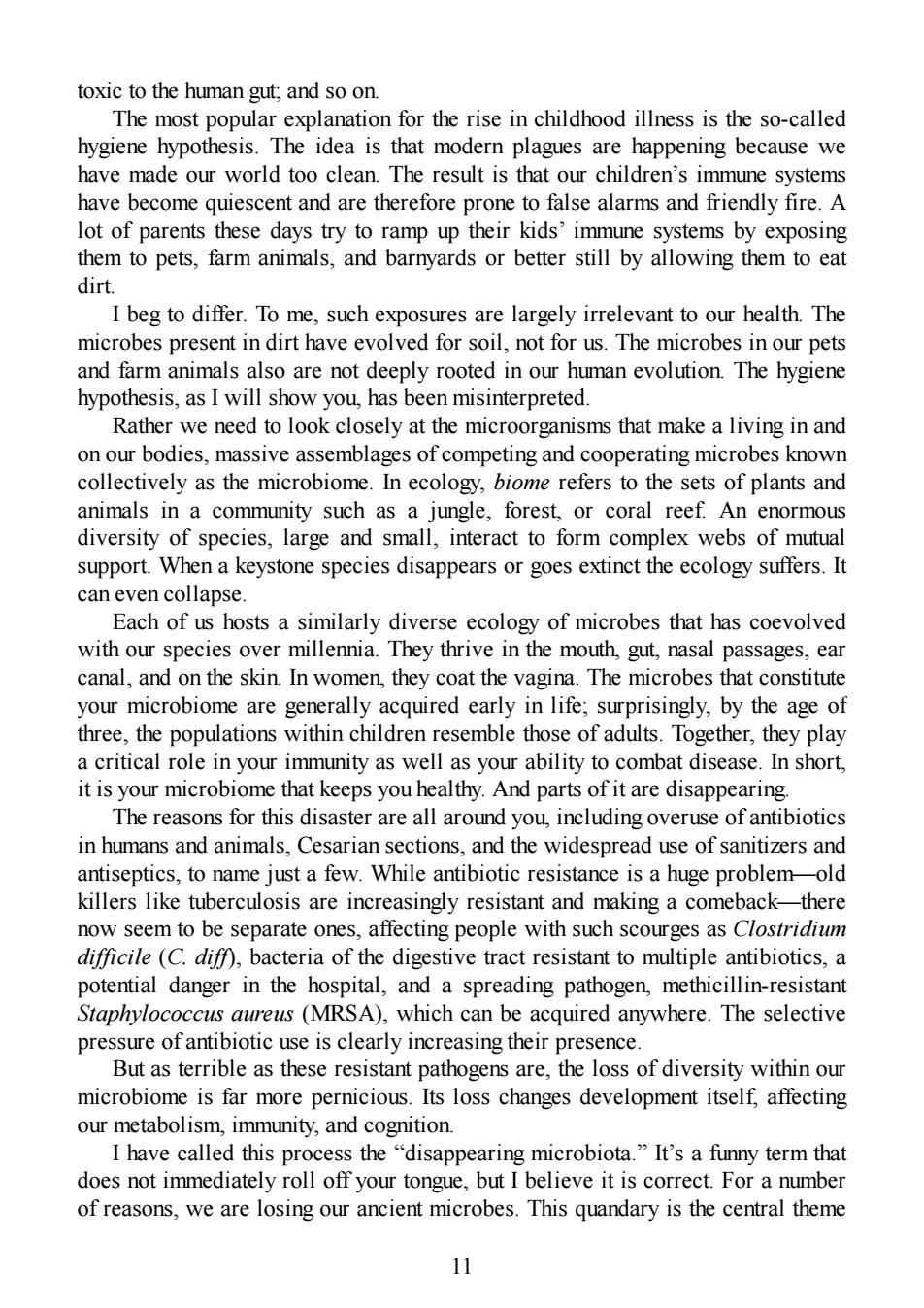正在加载图片...

toxic to the human gut:and so on. The most popular explanation for the rise in childhood illness is the so-called hygiene hypothesis.The idea is that modern plagues are happening because we have made our world too clean.The result is that our children's immune systems have become quiescent and are therefore prone to false alarms and friendly fire.A lot of parents these days try to ramp up their kids'immune systems by exposing them to pets,farm animals,and barnyards or better still by allowing them to eat dirt. I beg to differ.To me,such exposures are largely irrelevant to our health.The microbes present in dirt have evolved for soil,not for us.The microbes in our pets and farm animals also are not deeply rooted in our human evolution.The hygiene hypothesis,as I will show you,has been misinterpreted. Rather we need to look closely at the microorganisms that make a living in and on our bodies,massive assemblages of competing and cooperating microbes known collectively as the microbiome.In ecology,biome refers to the sets of plants and animals in a community such as a jungle,forest,or coral reef.An enormous diversity of species,large and small,interact to form complex webs of mutual support.When a keystone species disappears or goes extinct the ecology suffers.It can even collapse. Each of us hosts a similarly diverse ecology of microbes that has coevolved with our species over millennia.They thrive in the mouth,gut,nasal passages,ear canal,and on the skin.In women,they coat the vagina.The microbes that constitute your microbiome are generally acquired early in life;surprisingly,by the age of three,the populations within children resemble those of adults.Together,they play a critical role in your immunity as well as your ability to combat disease.In short, it is your microbiome that keeps you healthy.And parts of it are disappearing The reasons for this disaster are all around you,including overuse of antibiotics in humans and animals.Cesarian sections,and the widespread use of sanitizers and antiseptics,to name just a few.While antibiotic resistance is a huge problem-old killers like tuberculosis are increasingly resistant and making a comeback-there now seem to be separate ones,affecting people with such scourges as Clostridium difficile (C.dim),bacteria of the digestive tract resistant to multiple antibiotics,a potential danger in the hospital,and a spreading pathogen,methicillin-resistant Staphylococcus aureus (MRSA),which can be acquired anywhere.The selective pressure of antibiotic use is clearly increasing their presence. But as terrible as these resistant pathogens are,the loss of diversity within our microbiome is far more pernicious.Its loss changes development itself,affecting our metabolism,immunity,and cognition I have called this process the "disappearing microbiota."It's a funny term that does not immediately roll off your tongue,but I believe it is correct.For a number of reasons,we are losing our ancient microbes.This quandary is the central theme 11 toxic to the human gut; and so on. The most popular explanation for the rise in childhood illness is the so-called hygiene hypothesis. The idea is that modern plagues are happening because we have made our world too clean. The result is that our children’s immune systems have become quiescent and are therefore prone to false alarms and friendly fire. A lot of parents these days try to ramp up their kids’ immune systems by exposing them to pets, farm animals, and barnyards or better still by allowing them to eat dirt. I beg to differ. To me, such exposures are largely irrelevant to our health. The microbes present in dirt have evolved for soil, not for us. The microbes in our pets and farm animals also are not deeply rooted in our human evolution. The hygiene hypothesis, as I will show you, has been misinterpreted. Rather we need to look closely at the microorganisms that make a living in and on our bodies, massive assemblages of competing and cooperating microbes known collectively as the microbiome. In ecology, biome refers to the sets of plants and animals in a community such as a jungle, forest, or coral reef. An enormous diversity of species, large and small, interact to form complex webs of mutual support. When a keystone species disappears or goes extinct the ecology suffers. It can even collapse. Each of us hosts a similarly diverse ecology of microbes that has coevolved with our species over millennia. They thrive in the mouth, gut, nasal passages, ear canal, and on the skin. In women, they coat the vagina. The microbes that constitute your microbiome are generally acquired early in life; surprisingly, by the age of three, the populations within children resemble those of adults. Together, they play a critical role in your immunity as well as your ability to combat disease. In short, it is your microbiome that keeps you healthy. And parts of it are disappearing. The reasons for this disaster are all around you, including overuse of antibiotics in humans and animals, Cesarian sections, and the widespread use of sanitizers and antiseptics, to name just a few. While antibiotic resistance is a huge problem—old killers like tuberculosis are increasingly resistant and making a comeback—there now seem to be separate ones, affecting people with such scourges as Clostridium dif icile (C. dif ), bacteria of the digestive tract resistant to multiple antibiotics, a potential danger in the hospital, and a spreading pathogen, methicillin-resistant Staphylococcus aureus (MRSA), which can be acquired anywhere. The selective pressure of antibiotic use is clearly increasing their presence. But as terrible as these resistant pathogens are, the loss of diversity within our microbiome is far more pernicious. Its loss changes development itself, affecting our metabolism, immunity, and cognition. I have called this process the “disappearing microbiota.” It’s a funny term that does not immediately roll off your tongue, but I believe it is correct. For a number of reasons, we are losing our ancient microbes. This quandary is the central theme 11